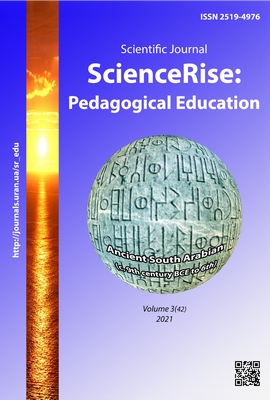Detailed analysis of the advantages of virtual laboratory works in physics
DOI:
https://doi.org/10.15587/2519-4984.2021.233937Keywords:
Information and communication technologies, virtual laboratory, virtual laboratory work, real laboratory work, advantages of virtual laboratory workAbstract
Due to the fact, that there is a significant modernization of university laboratory equipment, the widespread transition to computer measurement systems, the widespread introduction of Internet technologies for conducting theoretical and laboratory studies, a number of virtual laboratory works (VLW) have been developed using software resources, such as MATLAB, LabVIEW, LabVIEW Web services, VIPM Browser National Instruments, Wolfram Mathematica, Flash Adobe. The purpose of creating the lab works under consideration was to instill the skills of working with measuring instruments, independent measurements and calculations by each student, the ability to do research on the topic of lab by changing the initial conditions of the system and analyzing their influence on the behavior of the system.
It was studied, what in common and what differences have VLW and real laboratory work (RLW) in terms of didactic goals, their content, role in obtaining practical skills, acquiring research competencies. The definition of VLW and RLW, as well as the corresponding remote work, is given. The advantages, possibilities, expediency of the development and application of VLW, created on software products and simulating real physical processes, phenomena and patterns, are discussed.
Prospects for further research of VLW with the involvement of actual material of real laboratory work, methods of their software implementation and modeling packages are outlined
References
- Deyasi, A., Mukherjee, S., Mukherjee, A., Bhattacharjee, A. K., Mondal, A. (Eds.) (2021). Computational Intelligence in Digital Pedagogy. Singapor: Springer, 293. doi: http://doi.org/10.1007/978-981-15-8744-3
- Azad, A. K. M., Auer, M. E., Harward, V. J. (Eds.) (2011). Internet Accessible Remote Laboratories: Scalable E-Learning Tools for Engineering and Science Disciplines. IGI Global, 645. doi: http://doi.org/10.4018/978-1-61350-186-3
- Hatherly, P. A. The Virtual Laboratory and Interactive Screen Experiments. Available at: https://web.phys.ksu.edu/icpe/publications/teach2/Hatherly.pdf
- Muthusamy, K., Naidu, R. S., Fadzil, M. (2003). Merits and demerits of the virtual laboratories. Proceedings of the 17th AAOU Annual Conference. Bangkok, 52–58.
- Trukhin, A. V. (2002). Ispolzovanie virtualnykh laboratoriy v obrazovanii. Otkrytoe i distantsionnoe obrazovanie, 4 (8), 67–69.
- Bortnik, B. I., Stozhko, N. Yu., Sudakova, N. P., Yazovtsev, I. A. (2017). Virtualnye laboratornye raboty v vuzovskom kurse fiziki. Sovremennye problemy nauki i obrazovaniya, 5. Available at: https://www.science-education.ru/ru/article/view?id=26766
- Ramazanova, G. G. (2016). Preimuschestva i nedostatki ispolzovaniya virtualnykh laboratornykh rabot po fizike. Problemy i perspektivy informatizatsii fiziko-matematicheskogo obrazovaniya. Elabuga, 110–112.
- Mikhaylova, M. Yu., Pristavka, T. A., Kilin, S. V. (2015). Primenenie virtualnykh laboratornykh rabot v uchebnom protsesse vysshikh uchebnykh zavedeniy: za i protiv. Aktualnye problemy gumanitarnykh i estestvennykh nauk, 5-2, 97–100.
- List of computer simulation software. Available at: http://en.wikipedia.org/wiki/List_of_computer_simulation_software
- Shamshin, A. P. (2012). Kompyuterniy laboratorniy praktikum po magnetizmu, kolebaniyam i mekhanike s ispolzovaniem LabVIEW, MATLAB i Word. Inzhenernoe i nauchnoe prilozheniya na baze tekhnologiy National Instruments. Moscow, 195–197.
- Shamshin, O. P. (2016). Laboratorni roboty z vykorystanniam smartfonu u fizychnomu praktykumi. Novitni kompiuterni tekhnolohii, 14, 131–132.
- Shamshin, O. P. (2017). Dystantsiini laboratorni roboty u fizychnomu praktykumi. Novitni kompiuterni tekhnolohii, 15, 185–188.
- Pereschetniy pribor PP-16. Available at: http://forum.rhbz.org/topic.php?forum=81&topic=1
Downloads
Published
How to Cite
Issue
Section
License
Copyright (c) 2021 Alexandr Shamshin

This work is licensed under a Creative Commons Attribution 4.0 International License.
Our journal abides by the Creative Commons CC BY copyright rights and permissions for open access journals.
Authors, who are published in this journal, agree to the following conditions:
1. The authors reserve the right to authorship of the work and pass the first publication right of this work to the journal under the terms of a Creative Commons CC BY, which allows others to freely distribute the published research with the obligatory reference to the authors of the original work and the first publication of the work in this journal.
2. The authors have the right to conclude separate supplement agreements that relate to non-exclusive work distribution in the form in which it has been published by the journal (for example, to upload the work to the online storage of the journal or publish it as part of a monograph), provided that the reference to the first publication of the work in this journal is included.








